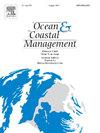Differential responses of Indo-Pacific humpback dolphin populations to climate change: Implications for future habitat shifts and conservation strategies
IF 5.4
2区 环境科学与生态学
Q1 OCEANOGRAPHY
引用次数: 0
Abstract
Understanding species' potential distribution is crucial for informing effective conservation strategies. The Indo-Pacific humpback dolphin (Sousa chinensis, IPHD), a vital indicator of marine ecosystem health, is increasingly threatened by human activities and climate change, and is currently listed as Vulnerable on the IUCN Red List of Threatened Species. By integrating species distribution records with ten environmental variables, we developed species-level (SLDMs) and population-level distribution models (PLDMs) to investigate the habitat preferences of IPHDs in China and evaluate their current and future habitat dynamics under different climate change scenarios. The SLDMs identified mixed layer depth as the primary environmental variable influencing the distribution of IPHDs, while the PLDMs revealed that the key environmental variable influencing distribution differs across different IPHD populations. The SLDMs projected a continuous reduction in suitable habitat for IPHDs over the next 70 years. The PLDMs indicated that larger IPHD populations, such as those in the Pearl River Estuary (PRE), Leizhou Bay (LZB), and Sanniang Bay (SNB), may serve as critical refugia with available habitats for transfer in the future, whereas smaller IPHD populations, including Xiamen-Jinmen (XJ) and Yuedong (YD) populations, are projected to face severe and progressive habitat loss, increasing their risk of local extinction. This research offers valuable insights for future protected area planning and the development of climate-appropriate conservation strategies.

印度-太平洋座头海豚种群对气候变化的差异反应:对未来栖息地转移和保护策略的影响
了解物种的潜在分布对于制定有效的保护策略至关重要。印度太平洋座头海豚(Sousa chinensis, ipd)是海洋生态系统健康的重要指标,受到人类活动和气候变化的威胁日益严重,目前已被世界自然保护联盟(IUCN)列入濒危物种红色名录。通过将物种分布记录与10个环境变量相结合,建立了物种水平(sldm)和种群水平分布模型(pldm),研究了不同气候变化情景下中国内陆植物的生境偏好,并评估了其当前和未来的生境动态。sldm将混合层深度确定为影响ipd分布的主要环境变量,而pldm揭示了影响ipd分布的关键环境变量在不同ipd种群之间存在差异。sldm预测,在未来70年里,适合植物生长的栖息地将持续减少。pldm结果表明,珠江口、雷州湾和三梁湾等较大的ipd种群在未来可能成为重要的栖息地转移避难所,而厦门-金门和粤东等较小的ipd种群将面临严重的栖息地丧失,局部灭绝的风险将增加。这项研究为未来保护区规划和气候适宜保护策略的发展提供了有价值的见解。
本文章由计算机程序翻译,如有差异,请以英文原文为准。
求助全文
约1分钟内获得全文
求助全文
来源期刊

Ocean & Coastal Management
环境科学-海洋学
CiteScore
8.50
自引率
15.20%
发文量
321
审稿时长
60 days
期刊介绍:
Ocean & Coastal Management is the leading international journal dedicated to the study of all aspects of ocean and coastal management from the global to local levels.
We publish rigorously peer-reviewed manuscripts from all disciplines, and inter-/trans-disciplinary and co-designed research, but all submissions must make clear the relevance to management and/or governance issues relevant to the sustainable development and conservation of oceans and coasts.
Comparative studies (from sub-national to trans-national cases, and other management / policy arenas) are encouraged, as are studies that critically assess current management practices and governance approaches. Submissions involving robust analysis, development of theory, and improvement of management practice are especially welcome.
 求助内容:
求助内容: 应助结果提醒方式:
应助结果提醒方式:


